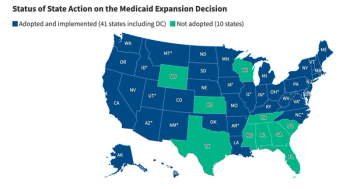
Asembia 2021: Explaining REMS Benefits. No Need for the Dread.
Risk Evaluation and Mitigation Strategies (REMS) programs are designed to protect patients, but they can also make providers more confident about prescribing a drug, explained panelists at the Asembia specialty pharmacy meeting. And the FDA collaborates with drugmakers on the planning the particulars of the programs, said Steve Granzyk and Tiffany Abraham.
Manufacturers with Risk Evaluation and Mitigation Strategies (REMS) programs in their future should not fear implementation, stressed panelists on a session today on REMS at the Asembia’s 2021 Specialty Pharmacy Summit.
In fact, REMS can greatly contribute to a product’s success and physician uptake, said
The main goal of REMS is ensuring patient safety and showing a product’s benefits outweigh the risks, said Granzyk and Abraham. The FDA requires manufacturers to create and maintain the program “when there are medications that have a patient need, but there are…risks around that and safety concerns for the patients,” explained Abraham.
REMS programs have stirred up some controversy. Some drugmakers have been being accused of abusing them and limited their distribution requirements for anticompetitive purposes.
But at the Asembia meeting, Abraham talked about the programs benefits to patients, including the reductions in the frequency and severity of adverse events.
The FDA “recommends what the REMS will be and what certain components will be; how complex it will be. But the manufacturer truly works to create that and collaborates with the FDA leading up to drug launch,” Abraham said.
A small fraction of REMS programs (10%) require only a medication guide, while more complex programs require elements to assure safe use (ETASU). ETASU can include enrollment registries, patient assessment prior to initiation, and other requirements, Abraham noted.
Pharmacies and health care settings come into the picture when restricted distribution is mandated in a REMS program, Abraham told the Asembia meeting attendees. Some programs may require pharmacies or healthcare providers to take certain steps before a drug is dispensed or administered.
Data collection is a component and, periodically, REMS programs are check for compliance, and the results are sent to the FDA, explained Granzyk and Abraham. The FDA can also assess compliance randomly, while the manufacturer has the power to audit REMS participants.
“From a specialty pharmacy perspective, you're always looking to limit the number of branches to what you actually need and to the extent that they're allowed in the pharma program,” said Granzyk. This benefits pharma as well, as it limits the diversion of product.
REMS programs boost provider confidence in a new drug because they provide that extra layer of data, confidence, and assurance he explained.
In addition to education, Granzyk highlighted the importance of internal collaboration between departments and innovation to mitigate errors and improve efficiency.
“A lot of people believe that REMS programs are very black and white, and they are, but there is always room for improvement and innovation,” said Abraham.
Newsletter
Get the latest industry news, event updates, and more from Managed healthcare Executive.





















































